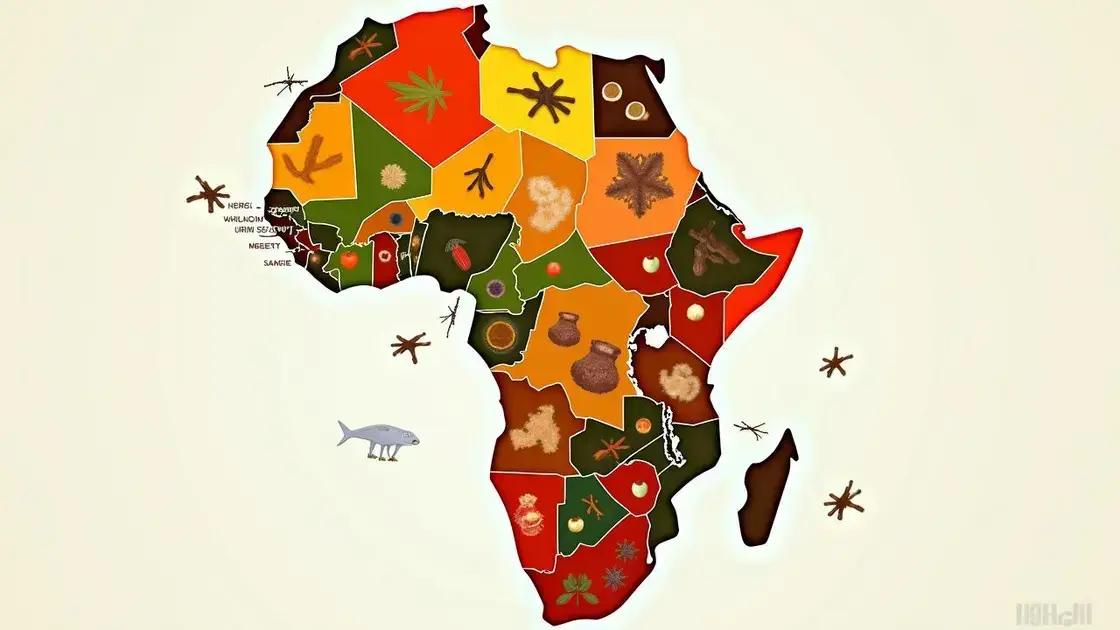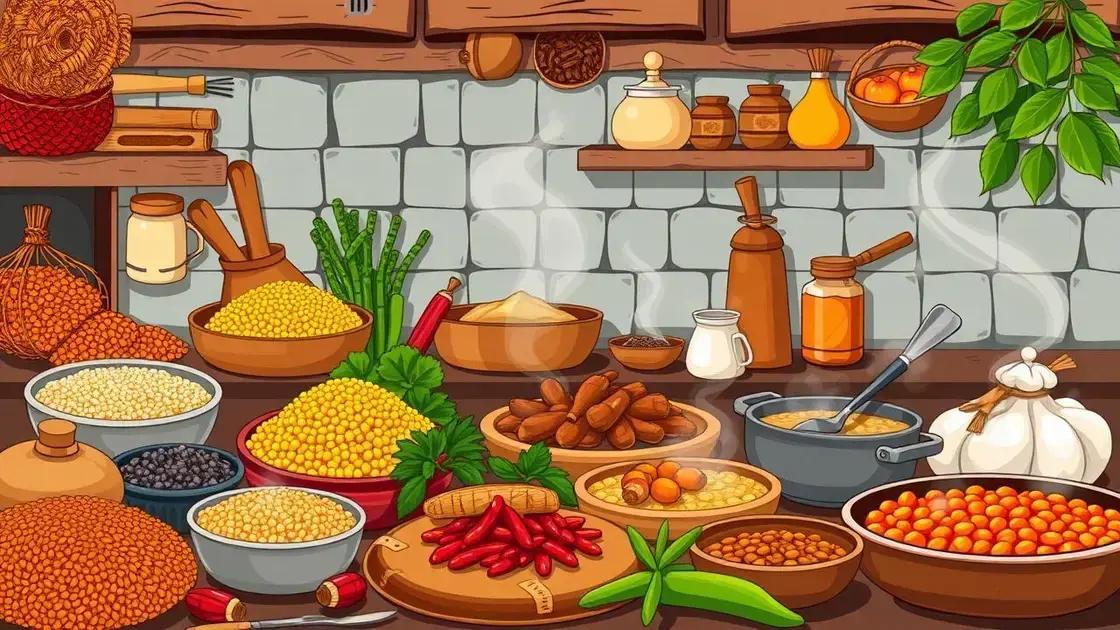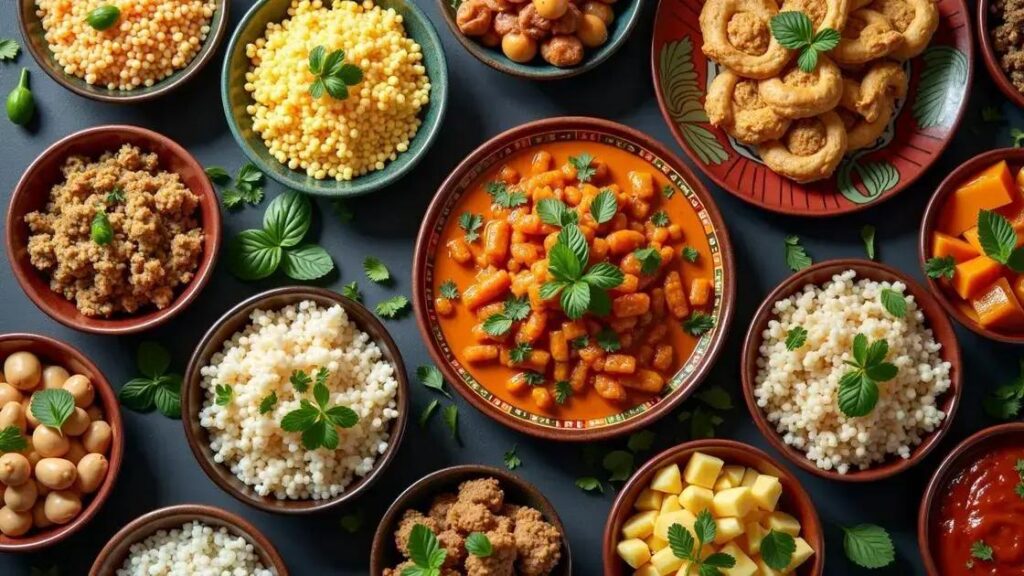Understanding the mechanics behind the African recipe reveals a rich tapestry of culinary traditions shaped by history, local ingredients, and diverse cooking techniques that celebrate community and culture.
Understanding the mechanics behind the African recipe allows us to delve into the vibrant culinary tapestry of the continent. Each region boasts unique flavors and techniques, providing a rich history that showcases cultural influences and local ingredients. In this article, we’ll explore the origins of African recipes and highlight key ingredients and cooking techniques that define these beloved dishes.
The Origins of African Recipes

The origins of African recipes are deeply rooted in the continent’s history and diverse cultures. Each region has its unique influences, shaped by geography, climate, and the movement of people. From the spices of North Africa to the grains in the Sub-Saharan regions, these culinary traditions tell a story of resilience and resourcefulness.
Historical Influences
Trade routes played a significant role in the development of African recipes. As traders and explorers moved across the continent, they brought diverse flavors and cooking techniques with them. For example, the introduction of rice and spices from the East shaped many West African dishes.
Cultural Significance
Food is not just for nourishment in African cultures; it holds ritual significance as well. Traditional recipes are often linked to celebrations, ceremonies, and communal gatherings. Share a meal, and you share a history.
Local Ingredients
Local ingredients play a crucial role in defining African recipes. Seasonality and regional availability dictate what is used, from root vegetables in the south to fish along the coasts. This reliance on local produce ensures that the food is fresh and environmentally sustainable.
Modern Influences
Today, African recipes are also influenced by globalization. Many chefs blend traditional elements with modern cooking styles, creating a fusion of flavors that reflect both heritage and innovation. This evolution keeps African cuisine dynamic and exciting.
Exploring the origins of African recipes enriches our understanding of its cultural significance and deliciousness. Each dish is a celebration of the resources and traditions of its people.
Key Ingredients and Cooking Techniques

Key ingredients and cooking techniques define the essence of African recipes. The diversity of the continent means we have an incredible variety of flavors and cooking methods.
Essential Ingredients
Common ingredients across African cuisines include grains, such as millet, sorghum, and rice, which serve as staples. Legumes like lentils and black-eyed peas are also popular, providing protein and nutrients to many dishes. Vegetables such as okra, sweet potatoes, and tomatoes are fundamental in adding flavor and texture.
Spices and Seasonings
In terms of spices, African cooking heavily relies on cumin, coriander, and chili peppers. These ingredients add depth and warmth to meals. Each region often has its unique spices, such as berbere in Ethiopia or harissa in North Africa.
Cooking Techniques
Cooking techniques vary greatly, from stewing and grilling to frying and baking. For instance, stews are common in many cultures, combining meats or vegetables with sauces and spices. Grilling is prevalent, especially along coastal areas, where fresh fish and meats are cooked over open flames.
Traditional Practices
Additionally, traditional cooking methods such as slow cooking in clay pots are still used, enhancing flavors and textures. Many dishes are prepared communally, encouraging shared meals and community bonding.
Understanding the key ingredients and cooking techniques highlights the creativity and cultural importance of African recipes, showcasing the ability to bring people together through food.
Embracing the Richness of African Culinary Heritage
In understanding the mechanics behind the African recipe, we uncover a world of incredible flavors, techniques, and cultural significance. The origins of African recipes tell stories of history and tradition, showcasing how local ingredients and diverse cooking methods create unique culinary experiences.
Key ingredients and cooking techniques serve as the foundation that brings these recipes to life. By blending spices, grains, and vegetables in innovative ways, chefs and home cooks alike pay homage to their heritage while creating dishes that resonate with many.
As we explore and appreciate African cuisine, we not only embrace its diversity but also strengthen the bonds within communities. Sharing meals brings people together, fosters understanding, and celebrates the richness of a vibrant culinary landscape.
FAQ – Frequently Asked Questions about African Recipes
What are the most common ingredients in African recipes?
Common ingredients include grains such as millet and rice, legumes like lentils, and fresh vegetables such as okra and tomatoes.
How do trade routes influence African cuisine?
Trade routes have historically introduced new ingredients and spices to various regions, shaping unique culinary traditions and flavors.
What cooking techniques are commonly used in African recipes?
Popular cooking techniques include stewing, grilling, frying, and using slow cooking methods in clay pots to enhance flavors.
Why is communal eating significant in African culture?
Communal eating fosters relationships and a sense of community, as meals are often shared during celebrations and special gatherings.
How can I learn more about African cooking techniques?
You can explore African cuisine through cookbooks, online cooking classes, or by visiting local restaurants that specialize in African food.
Are African recipes adaptable for modern cooking?
Yes, many African recipes can be adapted to modern cooking methods while retaining their cultural essence and flavors.












